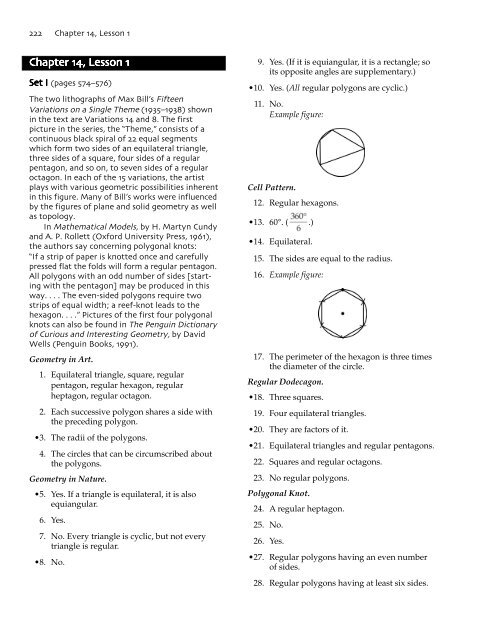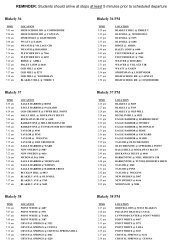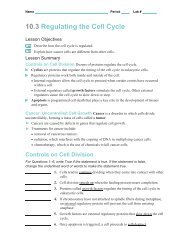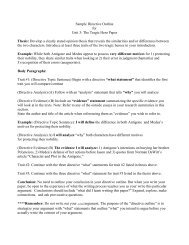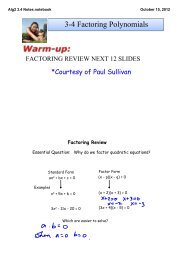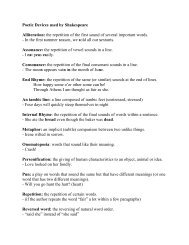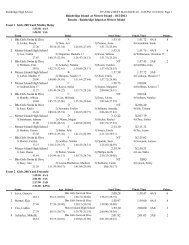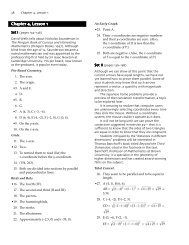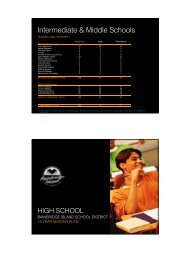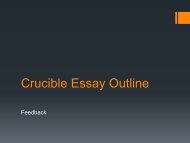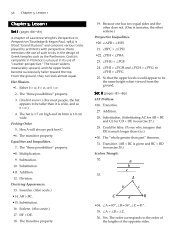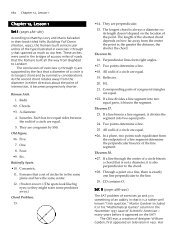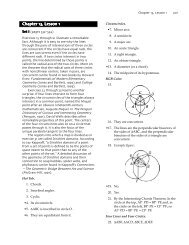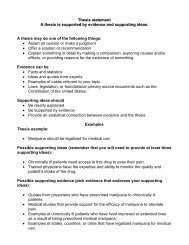Chapter 14 Answers - BISD Moodle
Chapter 14 Answers - BISD Moodle
Chapter 14 Answers - BISD Moodle
Create successful ePaper yourself
Turn your PDF publications into a flip-book with our unique Google optimized e-Paper software.
<strong>Chapter</strong> , Lesson <strong>Chapter</strong> , Lesson Set I (pages –)The two lithographs of Max Bill’s FifteenVariations on a Single Theme (–) shownin the text are Variations and . The firstpicture in the series, the “Theme,” consists of acontinuous black spiral of equal segmentswhich form two sides of an equilateral triangle,three sides of a square, four sides of a regularpentagon, and so on, to seven sides of a regularoctagon. In each of the variations, the artistplays with various geometric possibilities inherentin this figure. Many of Bill’s works were influencedby the figures of plane and solid geometry as wellas topology.In Mathematical Models, by H. Martyn Cundyand A. P. Rollett (Oxford University Press, ),the authors say concerning polygonal knots:“If a strip of paper is knotted once and carefullypressed flat the folds will form a regular pentagon.All polygons with an odd number of sides [startingwith the pentagon] may be produced in thisway. . . . The even-sided polygons require twostrips of equal width; a reef-knot leads to thehexagon. . . .” Pictures of the first four polygonalknots can also be found in The Penguin Dictionaryof Curious and Interesting Geometry, by DavidWells (Penguin Books, ).Geometry in Art.1. Equilateral triangle, square, regularpentagon, regular hexagon, regularheptagon, regular octagon.2. Each successive polygon shares a side withthe preceding polygon.•3. The radii of the polygons.4. The circles that can be circumscribed aboutthe polygons.Geometry in Nature.•5. Yes. If a triangle is equilateral, it is alsoequiangular.6. Yes.7. No. Every triangle is cyclic, but not everytriangle is regular.•8. No.9. Yes. (If it is equiangular, it is a rectangle; soits opposite angles are supplementary.)•10. Yes. (All regular polygons are cyclic.)11. No.Example figure:Cell Pattern.12. Regular hexagons.•13. 60°. ( .)•<strong>14</strong>. Equilateral.15. The sides are equal to the radius.16. Example figure:17. The perimeter of the hexagon is three timesthe diameter of the circle.Regular Dodecagon.•18. Three squares.19. Four equilateral triangles.•20. They are factors of it.•21. Equilateral triangles and regular pentagons.22. Squares and regular octagons.23. No regular polygons.Polygonal Knot.24. A regular heptagon.25. No.26. Yes.•27. Regular polygons having an even numberof sides.28. Regular polygons having at least six sides.
(<strong>Chapter</strong> , Lesson Set II (pages –)The approximate construction of the regularpentagon explored in exercises through isdiscussed in detail by J. L. Heilbron on pages and of Geometry Civilized (Clarendon Press,). For a pentagon to be regular, each of itsangles must have a measure of °. Unfortunately,in this particular construction, ∠A = ∠B ≈ .°,∠C = ∠E ≈ .°, and ∠D ≈ .°. The method,popular with medieval masons, was also includedby Renaissance artist Albrecht Dürer in his booktitled Course in the Art of Measurement withCompasses and Rulers ().Hidden in the figure for exercises through is the golden ratio. The appearance of the°-°-° isosceles triangles in the figure is thereason. Bisecting ∠ABF produces a trianglesimilar to ∆ABF. From this, it can be shown thatthe ratio of a leg of ∆ABF to its base is the goldenratio. It follows immediately from the figure thatthe diagonals of a regular pentagon cut eachother in this same ratio.Mason’s Pentagon.29.38. They are equal.•39. 22.5°. (∠AEI = 45° = 22.5°.)40. 135°. [∠EIH = 180° – 2(22.5°) = 135°.]•41. 135°. [∠IEJ = 90° + 2(22.5°) = 135°.]42. They are equal.43. They prove that it is regular.Hexagonal Fastener.44. Radii.•45. Apothems.46. PA = PB (all radii of a circle are equal) and∠APC = ∠BPD (vertical angles are equal);so ∆APC ≅ ∆BPD by HA.•47. 30°-60° right triangles.48. AC = = 0.125 in andPC =in ≈ 0.2165 in.49. AB = 2PA = 0.50 in andCD = 2PC = in ≈ 0.433 in.50. CD, because the wrench is used to grip thesides of the head, not its corners.Inscribed Pentagon.51.30. Yes. All five sides have been constructedequal to AB, the radius of the circles.•31. If it isn’t regular, it must not be equiangular.32. Yes. ∆ABF is regular because it is equilateraland therefore equiangular.Folding an Octagon.•33. Isosceles right triangles.34. SAS.35. Corresponding sides of congruent trianglesare equal.36. Isosceles (and obtuse).37. ASA. (All of their acute angles equal 22.5°.)•52. They are equal because the sides of thepentagon are chords of the circle, and equalarcs in a circle have equal chords.53. 72°. ( .)•54. 72°. [∠ABD = mAD = (2 ⋅ 72°) = 72°.]55. 72°. [∠AFB = (mAB + mCD) =(72° + 72°) = 72°.]( (
(<strong>Chapter</strong> , Lesson 56. 36°. (∠BAC = mBC = 72° = 36°.)57. 36°.58. Five.59. They are all isosceles.60. AEDF is a rhombus: AF = AB and FD = CD;so all four sides of AEDF are equal to thesides of the regular pentagon. BecauseAEDF is a rhombus, it follows that it is alsoa parallelogram.61. AEDB and AEDC are isosceles trapezoids.Set III (page )A chapter of Robert Dixon’s book titledMathographics (Dover, ) deals with “Euclideanapproximations” to some of the impossibleconstructions. As Dixon explains concerning theregular heptagon: “To divide a circle into exactlyseven equal parts would require us to be able toconstruct the angle of≈ .°, whichwe cannot do.” He then presents and analyzesthree comparatively simple constructions that areamazingly close approximations of the regularheptagon based on constructing angles ofapproximately .°, .°, and.°.A Close Construction.1.2. Equilateral.3. AO is the perpendicular bisector of XY(because A and O are equidistant from Xand Y.)4. A 30°-60° right triangle.5. OZ = r. (OZ = OY.)6. ZY = . (ZY = OZ.)7. AB = . (AB = ZY by construction.)8. AM = . (AM = AB.)9. 25.658906 . . .°. (sin ∠AOM = == = 0.433012702 . . .)10. 51.317812 . . .°. (∠AOB = 2∠AOM.)11. 359.22468 . . .°.12. That ABCDEFG is not regular. If ABCDEFGwere regular, 7∠AOB would equal 360°.<strong>Chapter</strong> , Lesson Set I (pages –)The figure showing the design of Palma Nuovasuggests that the city was surrounded by ninebastions (the spade-shaped regions) for itsdefense, as well as possibly by a moat.Students taking chemistry may wonder howeach hydrogen atom in the hydrogen fluoriderings can have two bonds. In his book titled TheArchitecture of Molecules (W. H. Freeman andCompany, ), Linus Pauling explains: “Manyproperties of substances can be easily explainedby the assumption that the hydrogen atom,which is normally univalent, can sometimesassume ligancy two, and form a bridge betweentwo atoms. This bridge is called the hydrogenbond. . . . Hydrogen fluoride gas has been foundto contain not only molecules HF, but alsopolymers, especially (HF) and (HF) . . . . Eachhydrogen atom is strongly bonded to one fluorineatom (bond length . Å) and less strongly toanother (bond length . Å).” “Å” is the symbolfor Angstrom, a unit of length equal to - cm( - m).The Susan B. Anthony dollar coin neverbecame popular, owing in part to the fact that itwas too easily confused with a quarter in bothlook and feel.Perimeter Equations.1. The radius.
<strong>Chapter</strong> , Lesson •2. The number of sides.3. 3.•4. 3.0902. (10 sin 18°.)5. 3.<strong>14</strong>11. (100 sin 1.8°.)6. 3.<strong>14</strong>16. (1,000 sin 0.18°.)7. 3.<strong>14</strong>16. (10,000 sin 0.018°.)8. It increases.9. It becomes more and more circular.Angles and Radii.•10. Radii.11. ∆ABP ≅ ∆CBP by SSS.12. ∠1 = ∠2 because corresponding parts ofcongruent triangles are equal.13. No.•<strong>14</strong>. PB bisects ∠ABC.Italian City.15. Nine.•16. 9 sin 20°.•17. 3.078.18. 6,772 ft. [2(3.078)(1,100).]Hydrogen Fluoride.19. A regular pentagon and a regular hexagon.20. They seem to be equal.•21. The radius of the hexagon appears to belonger.•22. 108°. ( .)23. 120°. ( , or 2 ⋅ 60°.)24. 12.5 angstroms. (5 × 2.5.)25. 15 angstroms. (6 × 2.5.)•26. 5 sin 36° ≈ 2.94.27. 6 sin 30° = 3.•28. Approximately 2.13 angstroms.[12.5 = 2(2.94)r, r ≈ 2.13.]29. 2.5 angstroms. [15 = 2(3)r, r = 2.5.]Dollar Coin.30. 75 mm. [c = 2πr = 2π(12) = 24π ≈ 75.]•31. 74 mm. [p = 2(11 sin )12 ≈ 74.]32. 7 mm. ( ≈ 7.)Set II (pages –)Most people who use them probably have no ideathat the name “cell phone” refers to the cells intowhich the areas in which they are used are dividedor that the cells have the same shape that beesuse in building honeycombs: the regular hexagon.Although regular pentagons cannot be usedto fill a plane as hexagons can be, the figure forexercises through shows that of themcan fit perfectly around a regular decagon. In hisbook titled Geometry in Architecture (Wiley,), William Blackwell observes that this is anice arrangement for surrounding a large -sidedpavilion with smaller galleries.Exercises through lead to Proposition of Book XIII of the Elements: “If an equilateralpentagon is inscribed in a circle, the side of thepentagon is equal in square to that of the hexagonand that of the decagon inscribed in the samecircle.” A good discussion of how this propositionis proved is included by Benno Artmann inEuclid—The Creation of Mathematics (Springer,). Artmann remarks concerning this theorem:“In other words, the side of the pentagon is thehypotenuse of a right triangle that has the sidesof the hexagon and of the decagon as its legs—a really unexpected and beautiful insight!” Afterexplaining that Euclid may have discovered thisremarkable theorem in his investigation of theicosahedron, Artmann also observes: “It is commonin mathematics that certain parts of complicatedproofs become of independent interest, andafterwards one wonders how anybody could havethought of them.”Phone Cells.33. p = 2Nr = 2(6 sin 30°)r = 2(3)r = 6r.
<strong>Chapter</strong> , Lesson 34.47. The tangent of an acute angle of a righttriangle is the ratio of the length of theopposite leg to the length of the adjacentleg.•48. = ≈ 2.2. (Because tan ∠X =and tan ∠XYZ = ,35. Equilateral triangles. The sides of each cellare equal to its radius; so the perimeter ofeach cell is 6r.36. Equilateral.•37. . [r is the hypotenuse of each 30°-60°right triangle included by ∆ABC; so thelength of the shorter leg is and the lengthof the longer leg is .AB = 2( ) = .]38. .•39. p = 2Nr = 2(3 sin 60°)r ≈ 5.196r.40. Yes. ≈ 5.196r.Ten Pentagons.•41. = 2.42. 36°. (∠X = = 36°.)43. 18°. (∠XYZ = = 18°.)•44. By the Law of Sines.•45. = ≈ 1.9.(Because = ,WZ = a tan ∠X = A tan ∠XYZ;so = .)Euclid’s Discovery.•49. 18°. ( = 18°.)50. 30°. ( = 30°.)51. 36°. ( = 36°.)•52. AX = 3.0901699 . . . . (sin 18° = ;so AX = 10 sin 18°.)53. BY = 5. (sin 30° = ; so BY = 10 sin 30°.)54. CZ = 5.8778525 . . . . (sin 36° = ;so CZ = 10 sin 36°.)55. a 2 = (2 AX) 2 = 38.19660 . . . .56. b 2 = (2 BY) 2 = 100.57. c 2 = (2 CZ) 2 = 138.19660 . . . .58. Euclid discovered that a 2 + b 2 = c 2 . If aregular decagon, hexagon, and pentagonare inscribed in circles of a given radius(or the same circle), the sum of the squaresof a side of the decagon and a side of thehexagon is equal to the square of a side ofthe pentagon.= = .)46. X and Y are equidistant from V and Z.(Two points each equidistant from theendpoints of a line segment determine theperpendicular bisector of the line segment.)
<strong>Chapter</strong> , Lesson Set III (page )This exercise suggests that the ratio of the lengthof a diagonal to the length of a side of a regularpentagon is the golden ratio. We are moreaccustomed to seeing this ratio in its algebraicform, sin °.Golden-Heather., than in its trigonometric form,1. ∠AOB = = 72°; so ∠AOX = 36°.sin ∠AOX = ; so sin 36° = .AB = 2AX = 2 sin 36°.2. ∠COE = 2∠AOB = <strong>14</strong>4°; so ∠COY = 72°.sin ∠COY = ; so sin 72° = .CE = 2CY = 2 sin 72°.3. = 1.6180339 . . . and2 sin 54° = 1.6180339 . . . .4. The golden ratio.<strong>Chapter</strong> , Lesson Set I (pages –)The expression M = n sin cos hasmeaning only when n is an integer larger than ,because n represents the number of sides of apolygon. Although a calculator readily finds sinesand cosines for any angle, our right triangledefinitions are valid only for acute angles.Nevertheless, with the use of a calculator whenn = or and there is no proper polygon, Mturns out to equal , suggesting that no area isenclosed.Exercises through provide anotherpreview of the fact that our work with regularpolygons will be useful in measuring the circle.Area Equations.1. The radius.2. The number of sides.•3. 0. (1 sin 180° cos 180°.)4. 0. (2 sin 90° cos 90°.)•5. 1.30. (3 sin 60° cos 60°.)6. 3.<strong>14</strong>. (180 sin 1° cos 1°.)7. 3.Inscribed Polygon.8. The area of the circle.•9. The perimeter of the nonagon.10. The length of a side of the nonagon.11. The circumference of the circle.The Area of a Square.12. A line segment that connects the center ofthe square to a vertex, or the distance fromits center to one of its vertices.13. s 2 .•<strong>14</strong>. 4a 2 . [s = 2a; so s 2 = (2a) 2 = 4a 2 .]15. An isosceles right triangle.•16. r = .17. r 2 = 2a 2 .•18. 2r 2 . (αABCD = 4a 2 and r 2 = 2a 2 ; soαABCD = 2r 2 .)19. (4 sin 45° cos 45°)r 2 = 2r 2 .Close But Not Quite.20. Its circumference.21. 628 units. [c = 2π(100) ≈ 628.]•22. 628 units. [p = 2(60 sin 3°)100 ≈ 628.]23. The circle.24. 3.<strong>14</strong>. [ .]25. 3.<strong>14</strong>.26. The circle.27. 31,416 square units. (a = π100 2 ≈ 31,416.)•28. 31,359 square units.[A = 60(sin 3° cos 3°)100 2 ≈ 31,359.]
<strong>Chapter</strong> , Lesson Set II (pages –)József Kürschák, the man associated with thegeometric proof that the area of a regulardodecagon having radius r is r , was a professorof mathematics at the Polytechnic University inBudapest for many years. He is also rememberedas the author of the Hungarian Problem Books Iand II, still available in the New MathematicsLibrary of the Mathematical Association ofAmerica.Honeycomb Geometry.44. That they are 150°. [180° – 2(15°).]45. ∠AHI = ∠HIC = 150°. [2(60°) + 2(15°).]46. r. (DH = DI = AB = BC = CD = DA = r.)•47. AH = HI = IC = (2 sin 15°)r ≈ 0.518r. [AH,HI, and IC are sides of a regular dodecagonwith radius r. Its perimeter is 2(12 sin 15°)r;so the length of each side is (2 sin 15°)r.]48. DE = DF = DG = (2 sin 15°)r ≈ 0.518r. (Theyellow triangles are isosceles.)29. Equilateral.30. An apothem.•31. 30°-60° right triangles.•49.r 2 . (BAHIC contains one-fourth of theexamples of each type of triangle that makeup the square.)•32. .50. r 2 . (r 2 – r 2 .)33. .•34. .35. .[αABCDEF = 6α∆AOB = 6( r 2 ) = r 2 .]36. (6 sin 30° cos 30°)r 2 .37. In ∆BOP, sin ∠BOP = = = .38. In ∆BOP, cos ∠BOP = = = .39. (6 sin 30° cos 30°)r 2 = (6( )( ))r 2 = .40. Yes. It agrees with the answer to exercise 35.Kürschák Triangles.41. ∆FHI and ∆BHI. Because they are equilateraland share a side, they are congruent by SSS.(Or, because they share a side and have 60°angles, they are congruent by ASA or SAS.)•42. They are isosceles.51. r 2 . (α∆DAH = αDAHIC.)Rats!52. (Student answer.) (The square has the largerradius.)53. (Student answer.) (The square has the largerperimeter.)•54. 7.1 cm. [100 = 4(sin 45° cos 45°)r 2 , 100 = 2r 2 ,r 2 = 50, r = ≈ 7.1.]55. 6.5 cm. [100 = 5(sin 36° cos 36°)r 2 ,100 ≈ 2.38r 2 , r 2 ≈ 42.0, r ≈ 6.5.]56. 40 cm. (Because s 2 = 100, s = 10, andp = 4s = 40.)•57. 38 cm. [p ≈ 2(5 sin 36°)(6.5) ≈ 38.]58. (Student answer.) (Both the radius and theperimeter of the pentagon are smaller thanthose of the square.)Hebrew Exercise.59. The problem is to prove that the area of aregular octagon having a radius of R isR 2 .60. A = (8 sin 22.5° cos 22.5°)R 2 ≈ 2.828R 2 , andR 2 ≈ 2.828R 2 .•43. That they are 15°. ( .)
<strong>Chapter</strong> , Lesson 61. 5. Approximately 1.42 square units.( ≈ 1.42.)<strong>Chapter</strong> , Lesson In ∆AOH, h = = ; soα∆AOH = HO ⋅ h = R( ) = R 2 .The area of the octagon is8α∆AOH = 8( R 2 ) = R 2 .Set III (page )More on the work of Marjorie Rice, includingseveral beautiful Escher-like tessellationsreproduced in full color, can be found in thechapter titled “In Praise of Amateurs” by DorisSchattschneider in The Mathematical Gardner,edited by David A. Klarner (Prindle, Weber &Schmidt, ) and on the Websitemembers.aol.com/tessellations. The centraltessellation with its sixfold rotation symmetrythat is the subject of the exercises was discoveredby Michael Hirschhorn, a teacher in New SouthWales.Congruent Pentagons.1. They are equilateral. (The colors along thesides of the pentagons can be used toestablish this.)2. The boundary of the figure is a regular18-gon because it is both equilateral andequiangular. (From the measures of theangles of the pentagonal pieces, we candetermine that each of the angles of the18-gon has a measure of 160°.)3. Approximately 2.88 units. Because theperimeter of the 18-gon is 18 andp = 2Nr = 2n sinSo r = ≈ 2.88.)r, 18 = 2(18 sin 10°)r.4. Approximately 25.53 square units.[A ≈ (18 sin 10° cos 10°)(2.88) 2 ≈ 25.53.]Set I (pages –)Hats are the only instance of a clothing size inwhich circumference is measured to determinediameter. A tape measure is wrapped around thewidest part of the head (about an inch above theeyebrows) to get the circumference of the innerband of the appropriate hat. Dividing this numberby π gives the hat size. This method works quitewell because the circle is a reasonable approximationof the cross section of a person’s head.The time that it takes the moon to travelonce around Earth, about . days, is called the“sidereal” month. The word “sidereal” means“determined by the stars,” and that is how theperiod of revolution was found. A “lunar” or“synodic” month is the time between twosuccessive new moons, about . days, and a“solar” month is one-twelfth of a solar year(about . days).In The Innovators (Wiley, ), DavidBillington wrote: “It has been argued that thesteamboat was the first great Americancontribution to modern technology.” Billington,a professor of civil engineering at Princeton,includes a wealth of information on RobertFulton’s calculations, including his patent formulasand the mathematics of his drag, power, andpaddlewheel calculations.The Babylonian-tablet exercises provideanother example of Pythagorean triples appearingmany centuries before Pythagoras was born.(If π is taken as ., the convenient relation ofthe sides of the triangle, surely intended by theproblem’s creator, is lost.) It seems strange,however, that the writer of a problem of thislevel would think that π was equal to .Francois Viète has been called the greatestFrench mathematician of the sixteenth century.In A History of π (Golem Press, ), PetrBeckmann reports that Viète was the first todiscover a way to represent π as an expression ofan infinite sequence of mathematical operations:π =
<strong>Chapter</strong> , Lesson Unfortunately, the expression is too cumbersomeand time consuming to be of practical use incalculating π, and so Viète was also one of thelast mathematicians to resort to using polygonsto do so. The number of sides used, ,,results from successive doublings ofArchimedes’ original hexagon.Circumference.1. Because d = 2r and c = 2πr = π(2r), c = πd bysubstitution.•2. π.3. 2π.Hat Sizes.4. ≈ 3.<strong>14</strong>3 and ≈ 3.138. (Both ratiosare approximately the value of π.)•5. The circumference of the hat.6. The diameter of the hat.The Moon’s Orbit.•7. Approximately 1,500,780 mi.[c = 2π(238,857) ≈ 1,500,783.]8. Approximately 656 hours.( ≈ 656.)9. Approximately 27.3 days. ( ≈ 27.3.)Semicircles.•10. πa.11. πb.12. π(a + b).13. Because π(a + b) = πa + πb, the length ofsemicircle C is equal to the sum of thelengths of semicircles A and B.<strong>14</strong>. No.Steamboat Geometry.15. 42,240 ft/hour. (8 × 5,280.)•16. 704 ft/minute. ( .)•17. <strong>14</strong>π ft.18. 16. ( ≈π16 revolutions/minute.)Babylonian Problem.19.•20. 10 units. [c = 2πr, 60 = 2(3)r, r = 10.]•21. 8 units. (OC = OD – CD = 10 – 2 = 8.)22. 6 units. (AC = = = 6.)23. With the assumption that π = 3, the sides of∆OAC form a Pythagorean triple: 6-8-10.(Or, the sides of ∆OAC are all integers.)•24. AC =AB. If a line through the center ofa circle is perpendicular to a chord, it alsobisects the chord.25. 12 units.Viète’s Calculation.•26. 3.<strong>14</strong>15927.(N = 393,216 sin ≈ 3.<strong>14</strong>15927.)27. No. The value must be less than π becausethe perimeter of a regular polygon isalways less than the circumference of acircle having the same radius.Perimeters and Diameters.•28. . (p = 4s and d = ; so•29. 2.83.= = = .)30. 3. (p = 6s and d = 2s; so = = 3.)31. π.
<strong>Chapter</strong> , Lesson 32. 3.<strong>14</strong>.33. Close to 3.<strong>14</strong> (or close to, but less than, π.)34. p = 2Nr and d = 2r; so = = N.N = 100 sin ≈ 3.<strong>14</strong>10759.Set II (pages –)Owing to Earth’s rotation, the speed at whichsomeone living on the equator is traveling,, miles per hour, is much faster than theofficial world land-speed record! Our speed dueto Earth’s motion around the sun, , milesper hour, is more than three times as great asthat of the Space Shuttle.Adam Kochansky published his constructionas “An Approximate Geometrical Constructionfor Pi,” and so he knew that it was not exact. Theexercises exploit the calculator in finding thevarious distances. It isn’t difficult to show (withoutusing a calculator) that the exact length of BE is. In Geometry Civilized (ClarendonPress, ), J. L. Heilbron, noting that Kochanskyliked to calculate, quotes him as saying: “Theperiphery thus found differs from the closestapproximation to the true Archimedean value[of pi] by less than the ratio of one to ten timesthe current year . . . .” Doing the calculation,+ = . . . . ,gives the value of π, . . . . correctly toseven decimal places.Going in Circles.•35. Approximately 24,880 mi. [Student roundingmay differ. c = 2π(3,960) ≈ 24,881.]•36. Approximately 1,040 mi.( ≈ 1,037.)•37. 1,040 mi/hour.38. Approximately 584,000,000 mi.[c = 2π(93,000,000) ≈ 584,336,234.]39. Approximately 1,600,000 mi.( ≈ 1,599,825.)40. Approximately 67,000 mi.( ≈ 66,659.)41. Approximately 67,000 mi/hour.•42. Approximately 19 mi/second.( ≈ 18.5.)Two Squares.43. HL. ∆ABO and ∆DCO are right triangleswith AB = DC because ABCD is a square;OB = OC because all radii of a circle areequal.44. OD = x. (OD = AD = x.)•45. r 2 =x 2 . [In right ∆DCO,r 2 = x 2 + ( x) 2 = x 2 .]•46. r 2 = y 2 . (In right ∆GPH, y 2 = r 2 + r 2 = 2r 2 ;so r 2 = y 2 .)47. x 2 = y 2 . (Because r 2 = x 2 and r 2 = y 2 ,x 2 = y 2 ; so x 2 = y 2 .)48. The area of ABCD is two-fifths of the areaof EFGH.SAT Problem.•49. 2a + 2b + 2c.50. 2πa + 2πb + 2πc.51. . [ = .]π π πVideotape.•52. 825 ft. ( = 825.)•53. π ≈ 3.<strong>14</strong> in. [c = 2π(0.5) = π.]54. 3π ≈ 9.42 in. [c = 2π(1.5) = 3π.]π π55. 2π ≈ 6.28 in. ( = 2π.)
<strong>Chapter</strong> , Lesson 56. About 1,576 times. ( ≈ 1,576.)Kochansky’s Construction.57.58. Equilateral.59. A 30°-60° right triangle.60. DA ≈ 0.5773503.(DA = = ≈ 0.5773503.)61. AE ≈ 2.4226497.(AE = DE – DA ≈ 3 – 0.5773503 = 2.4226497.)62. BE ≈ 3.<strong>14</strong>15333. (BE 2 = AB 2 + AE 2 soBE = ≈ 3.<strong>14</strong>15333.)63. It is a good approximation of π, correct tofive digits (or four decimal places).Set III (page )Tire Change.The ratio of the circumference of the larger tire tothe circumference of the smaller tire isπ ≈ 1.<strong>14</strong>; so, for each revolution of the tires,πthe truck goes 1.<strong>14</strong> times as far as before.70 miles × 1.<strong>14</strong> ≈ 79.8 miles. The truck would begoing about 80 miles per hour.<strong>Chapter</strong> , Lesson Set I (pages –)The area calculated in exercise for a typicalhurricane is more meaningful when comparedwith the areas of states such as Florida (,mi ) and Louisiana (, mi ), both of whichwere hit hard by Hurricane Andrew in .Another unit of circular area measure is the“circular mil,” defined as the area of a circlehaving a diameter of one “mil” (. in).Circular units of area are obviously of little valuein working with anything other than circles.Circular mils are used chiefly in the measurementof wire.Exercises through provide an example ofhow a good foundation in geometry is importantin calculus. Related rates and maximum/minimumproblems are particularly obvious examples inthat nearly every problem requires the use ofplane or solid geometry.Exercise is actually the first theorem ofArchimedes’ Measurement of a Circle: “The areaof a circle is equal to that of a right triangle inwhich one leg is equal to the radius and the otherto the circumference of the circle.”Although the result of exercises through, that in central pivot irrigation the number ofsubdivisions of a square region makes no differencein the area watered, may seem at first surprising,the reason is obvious when considered from theviewpoint of a dilation. No matter how small orlarge the cells might be, the ratio of the areas ofπeach circle and its corresponding square, ,remains constant.The use of the circle on a square grid toestimate π was first investigated by Gauss.According to David Hilbert and Stefan Cohn-Vossen in Geometry and the Imagination(Chelsea, ), Gauss “tried to determine thenumber f(r ) of lattice points in the interior andon the boundary of a circle of radius r, where thecenter of the circle is a lattice point and r is aninteger. Gauss found the value of this numberempirically for many values of n. . . . His interestwas prompted by the fact that an investigation ofthis function yields a method for approximatingthe value of π.” The details and an explanation ofthe procedure can be found on pages – ofHilbert’s book.Hurricanes.•1. 300 mi.•2. 940 mi. [c = π(300) ≈ 942.]•3. 71,000 mi 2 . [A = π(150) 2 ≈ 70,686.]•4. 15 mi. (700 = πr 2 , r =π≈ 15.)•5. 90 mi. [c = 2π(15) ≈ 94.]
<strong>Chapter</strong> , Lesson Square and Circular Inches.6. The area of a square with sides of length1 inch.7. The area of a circle with a diameter of1 inch.8. A square inch.•9. x 2 . ( = x 2 .)10. 100 square inches.π11. x 2 . [ = x 2 .]π•12. 100 circular inches.Ripples.13. 60 cm.•<strong>14</strong>. 3,600π cm 2 . [A = π(60) 2 = 3,600π.]•15. 60t cm.16. 3,600πt 2 cm 2 . [A = π(60t) 2 = 3,600πt 2 .]Equal Areas.17. 2πr (or, the circumference of the circle).If the areas are equal, πr 2 =AB = 2πr.Central-Pivot Irrigation.18. (Student answer.)ABr; so•19. 36π square units. [The diameter of eachcircle is 6; so the radius is 3. The total areaof the four circles is 4(π3 2 ) = 36π.]20. 36π square units. [The diameter of eachcircle is 4; so the radius is 2. The total areaof the nine circles is 9(π2 2 ) = 36π.]21. They are equal.Pi Square.22. π . (π = s 2 ; so s = π .)•23. π 2 . [A = πr 2 = π( π ) 2 = π 2 .]π24. π. ( = π.)πCircle on a Grid.•25. 6 units.26. 3.13888 . . . . ( = 3.13888 . . . .)•27. 3.<strong>14</strong>25. ( = 3.<strong>14</strong>25.)28. About 3.<strong>14</strong>11. ( ≈ 3.<strong>14</strong>107 . . . .)29. They suggest that the limit is π.30. About 31,416. ( ≈ π,p ≈ 10,000π ≈ 31,416. The number of pointsis actually 31,417.)Set II (pages –)Exercises through look at an early precursorof integration. Sawaguchi Kazuyuki published hismethod for finding the area of a circle in ,at about the time that Newton and Leibniz werediscovering the rules of the calculus. As PetrBeckmann observes in A History of π (GolemPress, ), in theory the method can be used tofind π to any desired degree of accuracy bychoosing a sufficiently large number of strips.Beckmann also points out that, in practice, theseries converges very slowly in addition torequiring the inconvenient extraction of squareroots.Area Problems.•31. 3πx 2 . [The radius of circle A is 2x; so its areais π(2x) 2 = 4πx 2 . The radius of circle B is x;so its area is πx 2 . The shaded area is4πx 2 – πx 2 = 3πx 2 .]32. 5πx 2 . [The radius of the larger circle is 3x;so its area is π(3x) 2 = 9πx 2 . The radius of thesmaller circle is 2x; so its area is π(2x) 2 = 4πx 2 .The shaded area is 9πx 2 – 4πx 2 = 5πx 2 .]•33. (4 – π)x 2 . [The side of square ABCD is 2x;so its area is (2x) 2 = 4x 2 . The radius of circleO is x; so its area is πx 2 . The shaded area is4x 2 – πx 2 = (4 – π)x 2 .]
<strong>Chapter</strong> , Lesson 34. (π – )x 2 . [Because ∆ABC is a 30°-60° righttriangle, AB = 2x and AC = . BecauseAB = 2x, OB = x; so the area of the circle isπx 2 . Because the legs of ∆ABC are x andSlicing a Circle.39., its area is x( ) = x 2 . Theshaded area is πx 2 – x 2 = (π – )x 2 .]•35. (5π – 8)x 2 . [The legs of each small righttriangle are 2x and x, and soOB = = = .The radius of circle O is ; so its area isπ( ) 2 = 5πx 2 . The area of the rectangle is(4x)(2x) = 8x 2 . The shaded area is5πx 2 – 8x 2 = (5π – 8)x 2 .]•36. ( – π)x 2 . [The small triangle is a30°-60° right triangle with shorter leg x, andso its longer leg is and AB = 2x .The area of equilateral ∆ABC isAB 2 = (2x ) 2 = x 2 . The radiusof the circle is x and so its area is πx 2 . Theshaded area is x 2 – πx 2 = ( – π)x 2 .]Cable Disaster.37. Scale drawing:38. The strength of the cable depends, not on itsdiameter, but on the area of its cross section.The area of a cross section of a 1-inch cableis π( ) 2 = π 2 in 2 . The total area of thecross sections of two-inch cables is2π( ) 2 = π 2 in 2 . The 1-inch cable shouldhave been replaced by four-inch cables.40. The height of the fifth strip is a leg of a righttriangle with hypotenuse 10 and base 5.h 2 + 5 2 = 10 2 ; soh = = = .The width of the strip is 1; so its area is1⋅ = .41. , , , , = 8, ,= 6, and . ( = ,•42. 72.6.•43. 290. [4(72.6) ≈ 290.]= , = , etc.)44. It would be less than the actual area of thecircle because the rectangular strips do notfill the quarter circle.45. Narrower strips should fill more of thecircle.46. Keep dividing the circle into narrower andnarrower strips.Tangent Circles.•47. a + b. [Its diameter is 2a + 2b = 2(a + b); soits radius is a + b.]•48. πa 2 + πab or πa(a + b). [The blue area is halfthe area of the largest circle plus half thearea of the left circle minus half the area ofthe right circle. π(a + b) 2 + πa 2 – πb 2 =π(a 2 + 2ab + b 2 ) + πa 2 – πb 2 =πa 2 + πab = πa(a + b).]
<strong>Chapter</strong> , Lesson 49. πab + πb 2 or πb(a + b). [The yellow area isfound in a similar way.π(a + b) 2 + πb 2 – πa 2 =π(a 2 + 2ab + b 2 ) + πb 2 – πa 2 =πab + πb 2 = πb(a + b).]π50. . [ = .]π51. Yes. If a = b, the two areas should be equal.We have shown that = ; so,if a = b, = 1, = 1, and soblue area = yellow area.52. 1. (Each border consists of three semicircles,one from each of the three circles.)Set III (page )In The Age of Faith (Simon & Schuster, ),Will Durant called Ramon Lull “one of thestrangest figures of the many-sided thirteenthcentury.” Lull wrote books in Catalan, Latin,and Arabic on such subjects as love poetry,theology, warfare, education, philosophy, andscience. According to Durant, “Amid all theseinterests he was fascinated by an idea that hascaptured brilliant minds in our own time—thatall the formulas and processes of logic could bereduced to mathematical or symbolical form.”More on Lull can be found in chapter ofScience—Good, Bad, and Bogus, by MartinGardner (Prometheus Books, ).Lull’s Claim.1. 2πr = 4s.2. πr 2 = s 2 .π3. Solving the first equation for s, s = .Substituting for s in the second equation,πr 2 π π= ( ) 2 , πr 2 = , 4πr 2 = π 2 r 2 , π = 4!<strong>Chapter</strong> , Lesson Set I (pages –)In Animal Navigation (Scientific AmericanLibrary, ), Talbot H. Waterman remarks thatdolphins, like bats, “use echolocation to find food,avoid obstacles, and maybe even to navigate overlonger distances. Repeated sound bursts . . .emanate from the head in a to ° beam.These directional high intensity clicks arereflected back by objects not completelyabsorbing them. Such echoes, which give adetailed sound picture of the environment atranges exceeding meters, are markedlybetter than the best underwater visibility.”Franz Reuleaux was a French engineer andmathematician who wrote an important book in on mechanisms in machinery. One of MartinGardner’s “Mathematical Games” columns inScientific American deals with the subject ofcurves of constant width, of which, other thanthe circle, the Reuleaux triangle is the simplestexample. This column is included in Gardner’sbook titled The Unexpected Hanging and OtherMathematical Diversions (Simon & Schuster, ).The curve was known to earlier mathematicians,but Reuleaux was the first to demonstrate itsconstant-width properties, including the fact thatit can be rotated inside a square without anyspace to spare. Exercises through prove thatthe perimeter of the Reuleaux triangle is thesame as the circumference of a circle having thesame width. It is also true that, of all curves ofconstant width having a given width, the Reuleauxtriangle is the curve with the smallest area.In Human Information Processing—AnIntroduction to Psychology (Harcourt BraceJovanovich, ), Peter H. Lindsay and DonaldA. Norman write concerning auditory spaceperception: “The cues used to localize a soundsource are the exact time and intensity at whichthe tones arrive at the two ears. Sounds arrivefirst at the ear closer to the source and withgreater intensity. The head tends to cast anacoustic shadow between the source and the earon the far side. With some simple calculations, itis possible to determine the approximatemaximum possible time delay between signalsarriving at the two ears.” These calculations aredone in exercises through . Lindsay andNorman observe that the human nervous systemis able to distinguish the time at which a soundreaches the ear within an accuracy of .
((<strong>Chapter</strong> , Lesson second! They also explain that sound localizationvaries with frequency: low frequency soundsbend easily around a person’s head, whereas highfrequency sounds, whose wavelength is shortcompared with the size of the head, do not.Although the degree seems to have been usedto measure angles since angles were firstmeasured, the radian was invented in byJames Thomson, the brother of the physicist LordKelvin (William Thomson). Unlike the degree,based on the arbitrary division of a circle into parts, the radian is a natural unit of anglemeasure. In Trigonometric Delights (PrincetonUniversity Press, ), Eli Maor remarks that the“reason for using radians is that it simplifies manyformulas. For example, a circular arc of angularwidth θ (where θ is in radians) subtends an arclength given by s = rθ; but if θ is in degrees, thecorresponding formula is s = πr. Similarly,the area of a circular sector of angular width isA = θr for θ in radians and A = πr for θ indegrees. The use of radians rids these formulas ofπthe ‘unwanted’ factor .” Maor adds: “Evenmore important, the fact that a small angle andits sine are nearly equal numerically—the smallerthe angle, the better the approximation—holdstrue only if the angle is measured in radians. . . .•8. 15,700 m 2 . (From exercise 6.)Latitude.•9. About 6,220 mi. [ 2π(3,960) ≈ 6,220.]10. About 69 mi. ( ≈ 69.)11. About 1,380 mi. (20 ⋅ 69 = 1,380.)Driveway Design.•12. 2,009 ft 2 . (41 ⋅ 49 = 2,009.)•13. 887 ft 2 . [2( π(18) 2 ) + 8 ⋅ 18 + 13 ⋅ 18 ≈ 887.]<strong>14</strong>. 1,122 ft 2 . (2,009 – 887 = 1,122.)Two Sectors.15. πr 2 .•16. πr 2 . [ π(2r) 2 = πr 2 .]17. The yellow and blue areas are equal.Reuleaux Triangle.•18. 60°. (mAB = ∠C = 60°.)•19. πx. ( 2πx = πx.)It is this fact, expressed as= , that20. 3x.makes the radian measure so important incalculus.”Orange Slices.•1. A sector.•2. 45°. ( .)πr•3. πr. ( .)•4. πr 2 .Sonar Beams.•5. The length of AB in meters.6. The area of sector DAB in square meters.7. 105 m. (From exercise 5.)21. πx. (3 ⋅ πx = πx.)•22. x. (c = πd = πx; so d = x.)Sound Delay.•23. About 9 in. [About (7) + (7π) ≈ 9.]24. 13,200 in. (1,100 ⋅ 12 = 13,200.)•25. About 0.0007 second.( ≈ 0.0007 second.)The Radian.26. 2πr.•27. 360°.
((<strong>Chapter</strong> , Lesson •28. . ( = .)π πr π29. 57.3°. ( ⋅ 360° ≈ 57.3°.)π•30. 57.3°. (∠AOB = mAB.)Set II (pages –)In a section titled “Lunatics” in GeometryCivilized—History, Culture, and Technique(Clarendon Press, ), J. L. Heilbron wrote:“Despite repeated failures, adventuresomegeometers over the ages have tried their handsat squaring the circle. One of the earliest andmost promising attempts was the work ofHippocrates of Chios, not the great physician buta man distinguished enough in his own line to benamed in the old texts as the first to compile anElements of Geometry. Hippocrates’ attempt atcircle-squaring involved ‘lunes,’ moon-shapedareas bounded by arcs of circles.” Exercises through consider one version of Hippocrates’lunes: four of them are equal in area to the verysquare on which they are constructed.Archimedes’ “salt cellar” problem is theorem from his Liber Assumptorum, or Book ofLemmas, a collection of theorems that hassurvived only in an Arabic translation.Windshield Wipers.•31. 46 in. [ 2π(22) ≈ 46.]•32. 469 in 2 .[ π(22) 2 – π(6) 2 ≈ 469.]33. No, because the areas wiped usuallyoverlap.Land Area.•34. ∠AOC ≈ 53°. (sin ∠AOC = ,∠AOC ≈ 53.13°.)35. ∠AOB ≈ 106°. (2 ⋅ 53° = 106°.)36. mAB ≈ 106°.•37. About 93 square units. [ π(10) 2 ≈ 93.]38. 48 square units. (Because OD = 10 – 4 = 6,α∆ABO = AB ⋅ OD = 16 ⋅ 6 = 48.)•39. About 45 square units. (93 – 48 = 45.)40. Yes.Running Track.•41. 63.66 m. (100 = πd, d = ≈ 63.66.)π42. 66.06 m. [63.66 + 2(1.2) = 66.06.]•43. 103.77 m. [ π(66.06) ≈ 103.77.]44. 25. ( = 25.)•45. About 188 m. (103.77 – 100 = 3.77;25 laps is 50 semicircles; 50 ⋅ 3.77 ≈ 188.)46. About 24 m![ 2π(R + 0.15) – 2πR = 0.15π ≈ 0.47;50 ⋅ 0.47 ≈ 24.]Four Crescents.•47.. (∆AOB is an isosceles right trianglewith legs equal to 2.)48. .•49. 4π. [π(2) 2 = 4π.]•50. 8. [( ) 2 = 8.]•51. 4π – 8.52. π – 2. (π= π – 2.)•53. π. [ π( ) 2 = π.]54. 2. [π – (π – 2) = 2.]55. 8.56. They prove that the four yellow crescentsare together equal in area to the greensquare.Drop-Leaf Table.57. 20 in.•58. 1,256.64 in 2 . [π(20) 2 = 400π ≈ 1,256.64.]
<strong>Chapter</strong> , Lesson 59. 60°. (Because CO = 2OH, ∆COH is a 30°-60°right triangle; so ∠COH = 60°.)60. 120°.61. 418.88 in 2 . [ π(20) 2 ≈ 418.88.]•62. 34.64 in.[CD = 2CH = 2( ) = ≈ 34.64.]63. 173.2 in 2 .[α∆COD ≈ (34.64)(10) = 173.2.]•64. 246 in 2 . (418.88 – 173.2 = 245.68.)65. 765 in 2 . [1,256.64 – 2(245.68) = 765.28.]Salt Cellar.•66. 2a + b.•67. 2a + 2b.[CD = (2a + b) + b = 2a + 2b.]68. a + b.69. π(a + b) 2 .70. The area of the “salt cellar” is equal toπ(2a + b) 2 – 2( πa 2 ) + πb 2 =π(4a 2 + 4ab + b 2 ) – πa 2 + πb 2 =2πa 2 + 2πab + πb 2 – πa 2 + πb 2 =πa 2 + 2πab + πb 2 = π(a 2 + 2ab + b 2 ) = π(a + b) 2 .Set III (page )This exercise is based on the “pizza problem”discussed in detail by Joseph D. E. Konhauser,Dan Yelleman, and Stan Wagon in Which WayDid the Bicycle Go? (Mathematical Association ofAmerica, ): “Suppose four cuts are madethrough a point P in a disk so that the eightangles at P are all equal to °. If the resultingeight pizza slices are colored alternately black andwhite, must the white area equal the black area?”That the answer is “yes” was first discovered andproved by L. J. Upton in . As Konhauser,Yelleman, and Wagon explain: “It turns out thatthe equal-area property holds if and only if thenumber of chords is even and greater than orequal to (equivalently, the number of pizzaslices is , , , . . .). They include a proof bydissection for the -chords case and a proof usingcalculus and polar coordinates of the generalcase. There is a nice photograph of Stan Wagonon the last page of the book with a granitesculpture illustrating the dissection solution tothe problem.To prove, then, that Acute Alice’s division ofthe pizza is a fair one is clearly not something ofwhich a beginning geometry student is capable.To find a fairly obvious counterexample toObtuse Ollie’s claim, however, is fairly easy to do,as the figure below illustrates.Pizza Puzzle.Example figure for two cuts:This figure shows that Ollie’s method may easilyresult in one pair of opposite pieces having agreater area than the other pair. Strange as it mayseem, regardless of where point P is chosen,Alice’s method results in two sets of alternatingpieces that are equal in area!<strong>Chapter</strong> , ReviewSet I (pages –)Of cholesterol, P. W. Atkins wrote in Molecules(Scientific American Library, ): “Althoughthis molecule has an elaborate, rigid, hydrocarbonframework, its business end (more formally, itsfunctional group) is primarily the –OH group.In other words, cholesterol is chemically anelaborate alcohol (hence the –ol in its name.)”In a line formula for an organic molecule, theline segments represent the bonds between thecarbon atoms, which are understood to belocated at their endpoints unless otherwisemarked. The hydrogen atoms are usually ignored.The cholesterol molecule contains carbonatoms, oxygen atom, and hydrogen atoms.In Book IV of the Elements, Euclid discussesinscribed and circumscribed polygons—thetriangle (Propositions and ), the square(Propositions through ), the regular pentagon
(((((((((((<strong>Chapter</strong> , Review(Propositions through ), the regular hexagon(Proposition )—concluding with the regular-gon (Proposition ). In his commentary onthe Elements (Cambridge University Press, ),Sir Thomas Heath wrote: “Proclus refers to thisproposition in illustration of his statement thatEuclid gave proofs of a number of propositionswith an eye to their use in astronomy. ‘With regardto the last proposition in the fourth Book in whichhe inscribes the side of the fifteen-angled figure ina circle, for what object does anyone assert thathe propounds it except for the reference of thisproblem to astronomy? For, when we haveinscribed the fifteen-angled figure in the circlethrough the poles, we have the distance from thepoles both of the equator and the zodiac, sincethey are distant from one another by the side ofthe fifteen-angled figure.’ This agrees with whatwe know from other sources, namely that up tothe time of Eratosthenes (c.– B.C.) ° wasgenerally accepted as the correct measurement ofthe obliquity of the ecliptic.”Although the penny farthing bicycle reachedits peak of popularity in about , it is stillpopular in some parts of Europe. At the time ofthis writing, Hammacher Schlemmer was offeringa version of the bicycle handmade in the CzechRepublic for $,.!Concerning the Gothic arch, J. L. Heilbronwrote in Geometry Civilized—History, Culture,and Technique (Clarendon Press, ): “Theconstruction of the equilateral triangle, whichfigures so prominently in Euclid’s proofs, leads toa figure of great beauty and importance. . . . Thecurvilinear shape ACB is that of the basic Gothicarch. You can see it everywhere in churches builtduring the later middle ages. . . . At the thresholdof the study of geometry, in connection with thevery first proposition of Euclid, you haveencountered one of the most important andversatile elements of architecture.”Molecule.1. Regular hexagons and a regular pentagon.•2. It must be convex, equilateral, and equiangular.3. It becomes more circular.A Regular 15-gon.5. mAD = 72°. ( .)•6. mDB = 48°.(mDB = mAB – mAD = 120° – 72° = 48°.)7. mBE = 24°.(mBE = mDE – mDB = 72° – 48° = 24°.)8. B and E, C and F.(mBE = mCF = 24° =360°. BecausemEF = 72° = 3(24°), BE and CF are sides ofthe same regular 15-gon.)•9. 3.12. (N = 15 sin = 15 sin 12° ≈ 3.12.)•10. 3.05. (M = 15 sin 12° cos 12° ≈ 3.05.)11. π.( (•12. 6.24r. [p = 2Nr ≈ 2(3.12)r = 6.24r.]13. 3.05r 2 . (A = Mr 2 ≈ 3.05r 2 .)<strong>14</strong>. 0.42r. (s ≈ ≈ 0.42r.)Penny Farthing Bicycle.•15. About 420 turns. [ ≈ 420.]π16. About 3.77 ft. [c = 2π(0.6) = 1.2π ≈ 3.77.]17. About 1,401 turns. ( ≈ 1,401.)SAT Questions.•18. 2π 2 . [c = 2π(π) = 2π 2 .]19. . (1 = πd, d = .)ππ•20. 4π. [4π = 2πr, r = 2, A = π(2) 2 = 4π.]Semicircles on the Sides.π•21. a 2 π, b 2 π, and c 2 . [A = π( ) 2 π= a 2 , etc.]22. Yes. Because ∆ABC is a right triangle,a 2 + b 2 = c 2 . Multiplying each side of thisπ πequation by gives a 2 π+ b 2 π= c 2 .•4. mAB = 120°. ( = 120°.)
((<strong>Chapter</strong> , ReviewArea Comparisons.23. πr 2 .•24. πr 2 . [ π(2r) 2 = πr 2 .]25. They are equal. Because α1 + α2 = α2 + α3,α1 = α3 by subtraction.26. The yellow and red areas are equal. (Thisfollows from the result of exercise 25 andthe symmetry of the figure.)Gothic Arch.27.the smaller circle shrinks to a point, the chordbecomes the diameter of the larger circle andthe expression for the area of the ring, πR – πr ,becomes πR , the area of the larger circle.In exercises through , the studentsdiscover a surprising property of the heart-shapedcurve: any line through point O divides its borderinto two equal parts. We would expect this resultof a line through the center of a figure that haspoint symmetry, but not of a figure that does not.Cup Problem.32. (Student answer.) (From the symmetry of thefigure, AG and BH evidently have equallengths, as do GD and HC. The two lowerarcs appear to be longer than the two upperones.)•33. 45°. (mAG = ∠ABG = 45°.)π•34. 0.79. [ 2π(1) = ≈ 0.79.]( (( (•35. – 1. (Because ABFE is a square, BE = .BG = BA = 1; so EG = BE – BG = – 1.)•28. ≈ 1.732. [ s 2 = (2) 2 .]•29. π ≈ 2.094. [ π(2) 2 = π.]30. π – ≈ 0.362.•31. π – ≈ 2.457. [ + 2( π – ) =+ π – = π – .]Set II (pages –)The answer to exercise , the width of theUnited States, is, of course, very approximate.The air distance between San Francisco andNew York City, both with latitudes close to °,is , miles; the coast of Maine is roughly miles east of New York City.Exercises through are based on thesurprising fact that, given two concentric circlesin which a chord of the larger circle is tangent tothe smaller circle, the area of the ring betweenthe circles is determined solely by the length ofthe chord, regardless of the sizes of the circles! As36. 135°. (mGD = ∠GED = 45° + 90° = 135°.)•37. 0.98. [ 2π( – 1) = π( – 1) ≈ 0.98.]38. (Student answer.)Time Zones.•39. About 1,037 mi. [π≈ 1,037.]•40. About 3,034 mi. [In ∆ABO,cos 40° (or sin 50°) = ;so AB = 3,960 cos 40° ≈ 3,034.]41. About 19,060 mi. [2π(3,034) ≈ 19,060.]•42. About 794 mi. ( ≈ 794.)43. Approximately 3,000 mi. (4 ⋅ 794 = 3,176.)
(<strong>Chapter</strong> , ReviewFrom Dodecagon to Square.44. It is equilateral. The vertices of the dodecagondivide the circle into 12 equal arcs; so eacharc has a measure of = 30°.Two of the angles of the triangle areinscribed angles of the circle and eachintercepts an arc equal to four of these arcs;so each of these angles has a measure of(4 ⋅ 30°) = 60°.•45. (or about 1.4<strong>14</strong>). (A = Mr 2 ; so6 = 12 sin cos r 2 ,6 = 12 sin 15° cos 15°r 2 , 6 = 3r 2 , r 2 = 2,r = .)46. (or about 1.732). (A = Mr 2 ; so6 = 4 sin cos r 2 = 4 sin 45° cos 45°r 2 ,6 = 2r 2 , r 2 = 3, r = .)•47. 8.78. [p = 2Nr = 2(12 sin 15°) ≈ 8.78.]48. 9.80. [p = 2Nr = 2(4 sin 45°) ≈ 9.80.]49. It increases.Chord and Ring.50.54. The radii of the two circles are not needed tofind the area of the ring. The area dependsonly on the length of the chord. (In general,if AB = 2x, then AC = x, r 2 + x 2 = R 2 ,R 2 – r 2 = x 2 ; so the area of the ring is πx 2 .)Half a Heart.•55. 4π. {2[ 2π(1)] + 2π(2) = 2π + 2π = 4π.}56. ∠AOC = (180 – x)°.57. ∠OCE = (180 – x)°.(In ∆CEO, EO = EC; so ∠OCE = ∠AOC.)•58. ∠AEC = (360 – 2x)°.(∠AEC is an exterior angle of ∆CEO; so∠AEC = ∠AOC + ∠OCE.)•59. π. [ 2π(1) = π.]60. π. [ 2π(2) = π.]61. 2π. ( π + π = π = 2π.)62. Line CD bisects the border of the heartbecause the length of CAD, 2π, is half thelength of the border of the heart, 4π.Biting Region.•63. About 83 ft.[ 2π(15 – 10) + 2π(15) + 2π(15 – 12) =π ≈ 83.3.]64. About 557 ft 2 .[ π(15 – 10) 2 + π(15) 2 + π(15 – 12) 2 =51. OC ⊥ AB and OC bisects AB. (If a line istangent to a circle, it is perpendicular to theradius drawn to the point of contact and, ifa line through the center of a circle isperpendicular to a chord, it also bisects it.)π ≈ 556.8.]•52. πR 2 – πr 2 or π(R 2 – r 2 ).53. π. (Because AB = 2, AC = 1; so r 2 + 1 2 = R 2and R 2 – r 2 = 1.)


